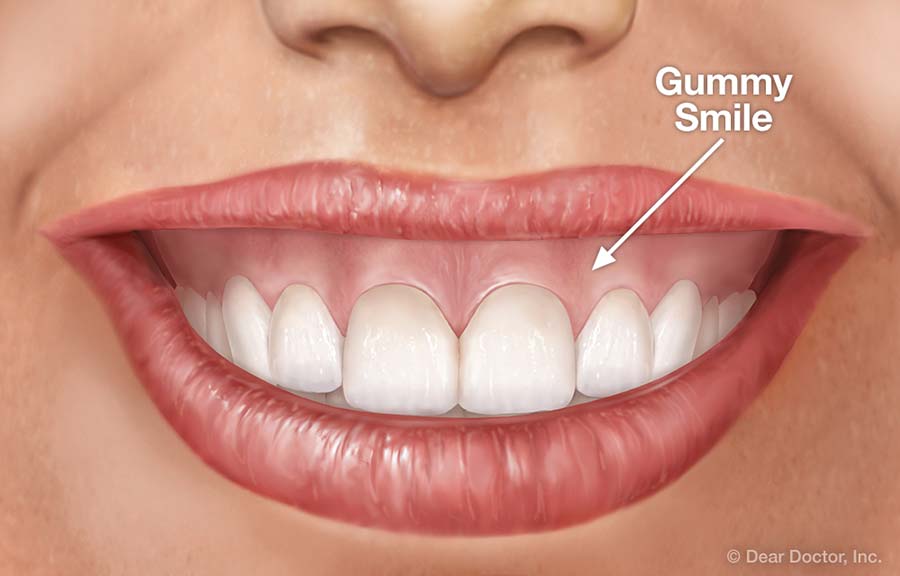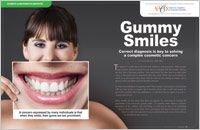 Some people feel self-conscious about smiling because they believe their gums are too prominent. Though we each have our own definition of what makes a smile beautiful — including how much gum is too much — a smile will usually be perceived as “gummy” when 4 millimeters (just over an eighth of an inch) of gum tissue shows. If your smile looks gummy to you, we can help figure out the cause and then propose one or more cosmetic dental or periodontal (gum) procedures to give you a more pleasing ratio of gums to teeth. Before we recommend a solution, however, we have to figure out what causing the gumminess in the first place.
Some people feel self-conscious about smiling because they believe their gums are too prominent. Though we each have our own definition of what makes a smile beautiful — including how much gum is too much — a smile will usually be perceived as “gummy” when 4 millimeters (just over an eighth of an inch) of gum tissue shows. If your smile looks gummy to you, we can help figure out the cause and then propose one or more cosmetic dental or periodontal (gum) procedures to give you a more pleasing ratio of gums to teeth. Before we recommend a solution, however, we have to figure out what causing the gumminess in the first place.
Causes
Gummy smiles may be caused by one or more factors relating to the gums themselves, the teeth, or even the lip or jaw. Each of these areas will require a different approach to solving the problem. Let's look at some of the ways a gummy smile can be corrected:
Gums. If your teeth appear too short in relation to your gums, it could be that they are being covered up by too much gum tissue. We can solve this problem with a periodontal plastic surgery technique called “crown lengthening,” which involves removing and reshaping the excess tissue to expose the full length of teeth.
Teeth. There are natural variations in the tooth-eruption process that can result in shorter than normal teeth and gumminess of the smile. If that's the case, we can often make your teeth appear longer by capping (crowning) them or covering them with thin porcelain veneers. It's also possible that your teeth have become worn down over time, especially if you have a grinding habit. When this happens, it can cause what is known as compensatory eruption. To compensate for the wear and maintain a functional bite, the teeth actually begin to move (or erupt) very slowly outward from the gum. This makes the smile appear gummier because the gums, which are attached to the teeth, move with them as they erupt. In some cases orthodontic treatment can be used to move the affected teeth back up into correct position. Afterwards, we would usually restore the worn-down teeth with porcelain crowns or veneers.
Lip. On average, the upper lip moves 6 to 8 millimeters from its normal resting position to a full smile. If the lip is hypermobile, meaning it rises much farther up, more gum tissue will be revealed. Here we will need to modify the action of the muscles that control the lip so they don't raise it quite so high. Treatment can range from Botox shots that temporarily paralyze the muscles (for about six months), to surgery that permanently restricts how high the lip can move, referred to as a lip stabilization procedure.
Jaw. Sometimes the upper jaw (maxilla) is too long for the face, a condition referred to as Vertical Maxillary Excess. If this is the case, the jaw would need to be repositioned with orthognathic surgery (“ortho” – straighten; “gnathos” – jaw). Of all the treatment listed here, this one is the most complex — but it can achieve dramatic results.
As you can see, there is no one-size-fits-all approach to correcting a gummy smile. However, we have various techniques at our disposal with which we have achieved dramatic improvements. We'd be happy to analyze the cause of your gumminess and recommend a solution to achieve your ideal smile.
Related Articles

Gummy Smiles
Sometimes a smile doesn't look as appealing as it could because the gums appear too prominent. If this describes your smile and it's something you want to change, chances are you can be helped by one of several available treatments. But first your dentist will need to determine exactly why your smile looks gummy to begin with. Find out the various causes and treatments... Read Article

Periodontal Plastic Surgery
Millions of Americans have some degree of gum recession — a loss of the tough, pink tissue that surrounds teeth. Receding gums can cause anything from minor tooth sensitivity to tooth loss in very severe cases. Fortunately, the field of periodontal plastic surgery has made enormous strides in devising techniques, including grafting, to deal with the problem of lost or damaged gum tissue... Read Article